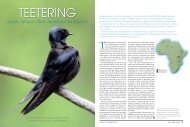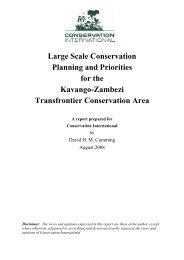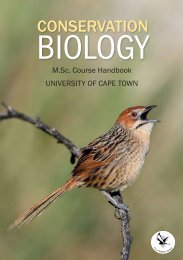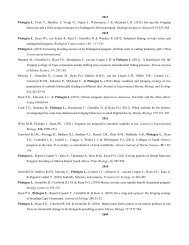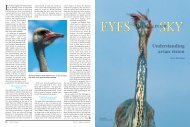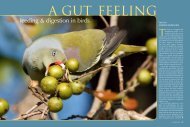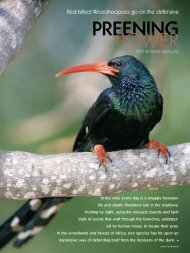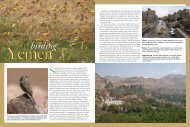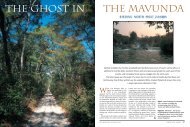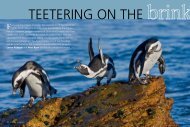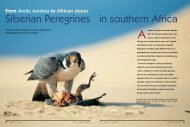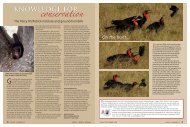Index of /depts/fitzpatrick/docs - Percy FitzPatrick Institute of African ...
Index of /depts/fitzpatrick/docs - Percy FitzPatrick Institute of African ...
Index of /depts/fitzpatrick/docs - Percy FitzPatrick Institute of African ...
Create successful ePaper yourself
Turn your PDF publications into a flip-book with our unique Google optimized e-Paper software.
doctoral research there. To this end, Eric Herrmann has beenappointed as a research manager at this field site and hecontinues to maintain the general capture and ringingmaintenance <strong>of</strong> the study. Claire Spottiswoode has continuedthe detailed work on this species (registered at Cambridge withPr<strong>of</strong> Nick Davies). Further, at the same site Eric Herrmann hasbeen hard at work catching and ringing a pilot group <strong>of</strong> AnteatingChats in order to allow deeper study into their socialbehaviour. This species is not only facultatively cooperative intheir breeding, but the males display white wing patches inwhat appear to be energetically expensive display flights. Thepotential exists for productive future research opportunities <strong>of</strong>this species.In collaboration with Pr<strong>of</strong> Ben Burger <strong>of</strong> StellenboschUniversity, we are collecting and analysing the chemicalcomposition <strong>of</strong> the uropygial gland secretions <strong>of</strong> Scimitarbills.To this end, we have set up a small number <strong>of</strong> nest boxessuitable for this species to breed and roost in so as to facilitatetheir study and capture.Field work continues on the Green Wood-Hoopoe project.Andy Radford has recently completed his fulltime work andgraduated with a PhD from Cambridge University, and anumber <strong>of</strong> manuscripts are currently in press. The study nowenters its 23 rd year and this large dataset has enabled us toanalyse data on the life-time reproductive success <strong>of</strong> 122woodhoopoes for which we have full breeding histories(Amanda Hawn’s MSc study).Highlights• The publication <strong>of</strong> a paper concluding that the extremesexual dimorphism in Green Wood-hoopoe bill length ismaintained by ecological separation to reduce foragingcompetition (Radford & du Plessis 2003).• The publication <strong>of</strong> a paper showing that there is strongstabilizing selection on adult Sociable Weaver body mass.This verifies the prediction that body mass is a trade-<strong>of</strong>fbetween the risks <strong>of</strong> starvation at low mass and predationat high mass (Covas et al. 2002).• The publication <strong>of</strong> a paper that suggests that amongSociable Weavers, adult survival in larger groups may beincreased by thermal advantages <strong>of</strong> a large nest duringcold winter weather. The fidelity <strong>of</strong> weavers to a particularcolony-size class between years may reflect phenotypicspecialization for certain group sizes (Brown et al 2003).StudentsAndrew Radford (PhD, Cambridge, graduated in June 2003);Foraging and vocal communication in the sexually dimorphicRed-billed WoodhoopoeClaire Spottiswoode (PhD, Cambridge); Behavioural ecologyand tropical life-histories in <strong>African</strong> birdsChristian Boix-Hinzen (MSc); Developing management tools forthe Conservation <strong>of</strong> Hornbills in a developing countryCollecting data in the field. Photo: Claire SpottiswoodeAmanda Hawn (MSc); The effect <strong>of</strong> territory quality on dispersaldecisions in a model population <strong>of</strong> Red-billed WoodhoopoeNimmi Seoraj (MSc, University <strong>of</strong> Durban-Westville) Warningvocalisations and predator information transfer in social birdsSamantha St<strong>of</strong>fberg (BSc Hons) worked on the fitnessconsequences <strong>of</strong> gender differences in helping behaviour <strong>of</strong>green wood-hoopoesLecturesPr<strong>of</strong>. du Plessis taught part <strong>of</strong> a seven-week module to UCTHonours students on ‘Birds as models <strong>of</strong> ecological theory’. Healso taught on the 3 rd year Behavioural Ecology Field Course atDe Hoop, and was responsible for a two-week lecture block on‘Conservation Biology’ to 2 nd year Zoology students.VisitorsPr<strong>of</strong>. Tom Martin (University <strong>of</strong> Montana, USA), Dr RichardPettifor (<strong>Institute</strong> <strong>of</strong> Zoology, London, UK), Dr AndrewMcKechnie (University <strong>of</strong> Natal, PMB, SA).AcknowledgementsDe Beers Consolidated Mines Limited (particularly MessrsGraham Main and Peter Gibbs), National ResearchFoundation, European Union, University ResearchCommittee (URC), Sean Cockin, Frank Cockin, JohanBreetzke, Willem Fourie, Trevor Brown, Mike Putzier, CarlVernon, and Kei Mouth Municipality.8 <strong>Percy</strong> <strong>FitzPatrick</strong> <strong>Institute</strong> Annual Report: July 2002 - June 2003



